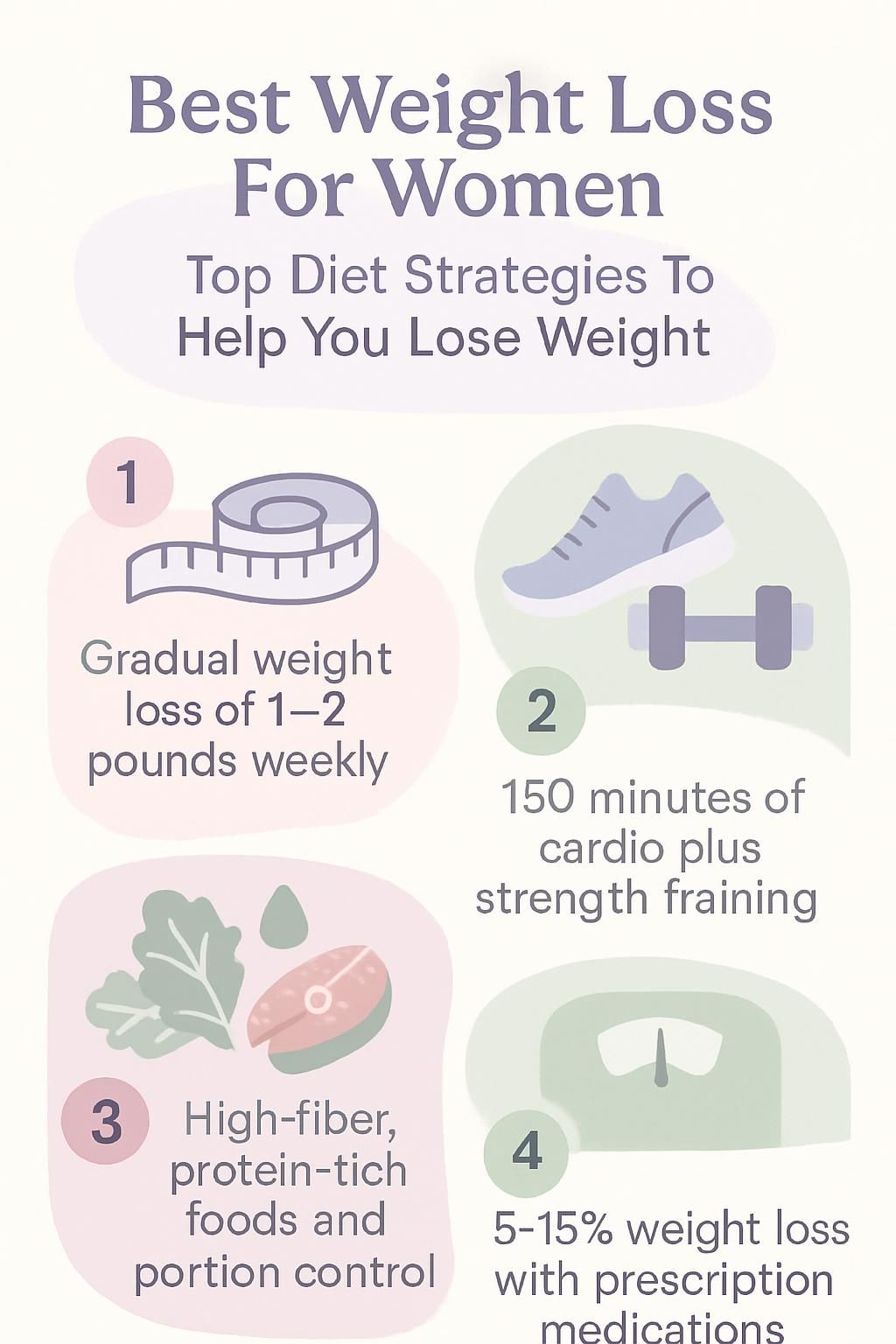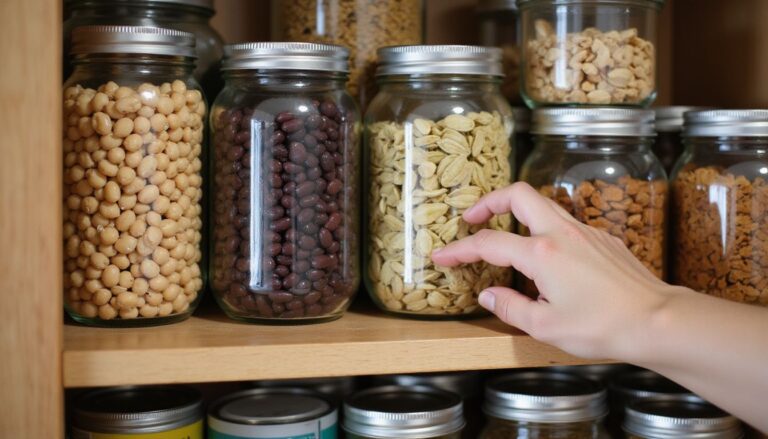Best Weight Loss For Women: Top Diet Strategies To Help You Lose Weight
Our Nutrition Assistant AI Suite will transform your body. You will lose fat, get toned, and build muscle. Gain confidence and optimal health.
Diet plans that promise quick results can feel discouraging when the pounds come back. Lasting weight loss takes steady habits, not extremes. In this guide on the best weight loss for women, you will learn diet strategies that fit real life, simple tips to help you lose weight, and how physical activity and smart meal planning support long-term success.
Use these ideas to choose an approach that you can maintain for months, not days.
Key Takeaways
- Aim for gradual weight loss of 1 to 2 pounds per week using balanced eating, regular exercise, and behavior changes, as recommended by Mayo Clinic.
- Helpful tactics include tracking food intake, eating more high-fiber vegetables, increasing protein, and practicing portion control to lower calories while protecting muscle.
- Target at least 150 minutes of moderate cardio and two strength sessions each week to boost calorie burn and improve long-term results.
- Health conditions such as hypothyroidism, PCOS, and menopause can slow progress. Talk with a healthcare professional and set goals that fit your situation.
- FDA-approved prescription options, including semaglutide or orlistat, may support 5 to 15 percent weight loss when lifestyle steps are not enough. Medical supervision is required.

What Are the Key Factors for Weight Loss in Women?

Hormones, age, and metabolism shape how easily you lose weight. Many women notice a slower metabolism around age 40, which makes fat loss harder. Conditions such as hypothyroidism, polycystic ovary syndrome, and menopause can also affect progress.
Build meals around whole grains, fruits, vegetables, and lean protein. Walking and strength training help you burn calories and keep muscle while your weight drops.
Guidance from a weight management program or a health professional raises your chances of success. Steady progress, about 1 to 2 pounds per week, supports long-term maintenance and lowers the odds of regaining weight.
Meal planning and portion control work better than fad diets that lead to rapid weight loss. Long-term commitment to healthy eating and regular movement also lowers the risk of diabetes, heart disease, stroke, and some cancers.
Healthy lifestyle changes can be your strongest tool for long-term weight management and lower health risks.
Start by checking your readiness and motivation. A clear plan begins with honest reflection.
Foundations for Successful Weight Loss
Strong foundations make change easier to keep. With the right structure, you can reach a goal weight and maintain it with confidence.
How Can You Evaluate Your Readiness to Lose Weight?
Readiness matters. A little planning upfront makes the path smoother and more realistic.
- Clarify why you want to lose weight and what will keep you going on hard days.
- List barriers such as work stress or family demands so you can plan around them.
- Review how you handle stress today. Consider help from a clinician or counselor if needed.
- Confirm you are willing to change both food habits and activity levels. Both matter.
- Decide how much time you can give each week to meal planning, prep, and exercise.
- Build a support system, such as friends or a group, to keep you encouraged and accountable.
- Set realistic goals, like losing 1 to 2 pounds per week, consistent with national guidance.
- Reduce processed sugars and increase dietary fiber, fruits, and vegetables to support a balanced diet.
- Commit to tracking food intake and physical activity since monitoring links to better long-term results.
- Note any health issues, like diabetes or high blood pressure, that add urgency to your goals.
- Reach out to qualified experts, such as a registered dietitian, for extra weight loss tips or support.
What Motivates Women to Lose Weight?
Personal reasons drive change. Better health, lower diabetes risk, and more daily energy often inspire steady action.
Write your reasons and keep them visible. Small reminders on a mirror or in your phone can boost daily focus.
Support from family, friends, or clinicians improves commitment. Tracking each pound lost, new habit built, or drop in body weight makes progress feel real. A Mayo Clinic Health System report found consistent tracking raised motivation.
“Your journey is unique, and your reasons for weight loss can keep you moving forward.”
How Do You Set Realistic Weight Loss Goals?
Clear, specific goals help you stay focused and measure progress. Think in steps, not leaps.
- Begin with a 5 percent loss from your current weight. At 180 pounds, that is about 9 pounds.
- Aim for 1 to 2 pounds per week, or 0.5 to 1 kilogram, following federal advice.
- Create a daily calorie deficit of 500 to 750 through intake, movement, or both.
- Set action goals, like walking 30 minutes daily, along with outcome goals such as losing 10 pounds.
- Track weekly with a journal or app. Use trends to guide small adjustments.
- Adjust goals when you hit plateaus or if health issues change.
- Avoid aggressive approaches that raise the risk of muscle loss or other problems.
- Work with your provider if you are pregnant, have kidney concerns, or use medications such as orlistat or GLP-1 drugs.
With goals in place, explore diet strategies that support safe and steady progress.
Effective Diet Strategies for Women
Diet choices should nourish your body and help you stay consistent. Pick an eating plan that you can follow during busy weeks.
What Is a Balanced Diet for Weight Loss?
A balanced diet focuses on fiber and nutrients. Aim for at least 4 servings of vegetables and 3 servings of fruit daily. These foods are low in calories and help you feel full.
Choose whole grains such as brown rice or oatmeal for steady energy. Add healthy fats from olive oil or nuts in small amounts. Choose low-fat or fat-free dairy instead of creamy sauces and rich desserts.
Cooking with fresh foods gives you more control over calories and sodium. This may reduce risk for heart disease and type 2 diabetes.
Practice mindful eating, which means paying attention to hunger and fullness cues. I swapped chips for carrot sticks and drank water before snacks, which helped me reduce grazing and lose extra pounds.
How Do Low-Calorie Diets Help Women Lose Weight?
Low-calorie diets, often 1,200 to 1,500 calories per day, reduce daily energy intake. Some plans use a mix of meal replacements and regular foods.
When calories drop, your body uses stored fat for fuel. Studies show calorie reduction plays a bigger role in quick weight changes than exercise alone.
Many people find low-calorie diets easier to maintain than very low-calorie versions. After following Mayo Clinic patient guidance, I lost weight at a comfortable pace without feeling deprived.
These plans are not suitable for pregnancy, older age, or minors without supervision. In women who need to lose weight, steady calorie cuts can reduce abdominal fat and lower some health risks.
What Are Very Low-Calorie Diets and Are They Safe?
Very low-calorie diets cut intake to about 800 calories per day. Meal replacements such as shakes, bars, soups, or special formulas provide most calories.
Weight loss can reach 3 to 5 pounds per week. Clinicians may use these diets for adults with obesity, often before surgery.
Medical supervision is required. Risks include loss of muscle and bone, gallstones, and gout. Do not follow a very low-calorie diet for more than 12 weeks.
When I tried a strict meal replacement plan, my energy dropped and digestion changed. These plans are not intended for pregnancy, older adults, or those without obesity. Always consult your provider before major changes.
How Does Time-Restricted Eating Promote Weight Loss?
Time-restricted eating limits meals to a set window, for example 8 hours, with a 16 hour fast, known as 16:8. Fewer eating hours often leads to fewer calories and fewer snacks.
Some research suggests this method can help adults lose meaningful weight, though long-term data are limited. A rest period for your digestive system may improve insulin sensitivity, which helps your body control blood sugar.
Many notice early progress. A defined eating window helped me stop late-night snacking, which made portion control easier.
What Are the Benefits of Intermittent Fasting?
Intermittent fasting, such as the 5:2 pattern, includes five regular days and two low-calorie days each week. It can reduce weekly calories without daily restriction.
Studies from 2017 show it can help people who struggle with traditional calorie counting. This approach may improve insulin sensitivity and reduce risks linked to heart disease. Some people also see improved cholesterol and better blood sugar control.
Many women find hunger manageable on non-fasting days compared with standard low-fat diets. The timing structure can make it easier to follow dietary guidelines without feeling deprived.
Why Focus on High-Protein Diets for Weight Loss?
Protein protects muscle during weight loss. It also increases fullness, which makes a calorie deficit easier to maintain and reduces the urge to snack.
Women who eat at least 1.2 grams of protein per kilogram of body weight tend to lose more fat and less muscle. Choose lean meat, fish, eggs, dairy, legumes, nuts, and seeds for balanced nutrition.
Pair protein with strength training to preserve muscle while your weight drops. The Dietary Guidelines for Americans support balanced meals that include protein at each meal.
Developing Healthy Eating Practices
Smart eating habits help you manage human body weight and improve long-term health. Small, repeatable steps add up.
How Can You Control Portion Sizes Effectively?
Portion control keeps calories in check. Small shifts done daily can create steady progress.
- Use 9 inch plates or smaller. People tend to eat fewer calories with smaller dishes.
- Pre-portion snacks into containers at home. It is easier to track how much you eat.
- Share restaurant meals or save half for later. Many servings are far larger than you need.
- Eat slowly. Give your digestive system time to signal fullness.
- Fill half your plate with low-calorie vegetables like spinach and carrots to increase fullness.
- Measure servings with cups or a food scale until you can estimate well.
- Drink water before meals. Many people eat less when they start hydrated.
- Switching to smaller plates helped me spot real hunger, not habit eating, which improved my results.
These tactics match guidance used by nutrition experts and can support a healthier life through practical steps.
Why Are Consistent Meal Times Important for Weight Loss?
Eating on a schedule reduces extreme hunger and makes it easier to manage total calories. A plan also limits impulse choices.
Research links regular meal times with fewer binges and less mindless snacking. Free tools like the USDA MyPlate Plan can help you prep meals and snacks ahead of time.
Sunday lunch prep helped me skip fast food during hectic days. Stable meal timing also supports blood sugar control and may ease cravings for sweets.
Consistency reduces stress around food choices and supports weight management over time.
What Whole Grains, Fruits, and Vegetables Should You Add?
Fiber rich foods curb appetite and deliver key nutrients. They also support heart and gut health.
- Add whole grains such as brown rice and barley for longer lasting fullness.
- Choose at least 4 servings of vegetables daily, including carrots, broccoli, leafy greens, and bell peppers.
- Include at least 3 servings of fruit, such as berries, apples, and oranges.
- Swap refined grains for whole versions, such as oatmeal or whole wheat bread.
- Boost fiber with beans and lentils to steady hunger and support weight goals.
- Favor minimally processed plant foods to limit additives.
- Pick seasonal produce for variety and flavor.
- Use non-starchy vegetables more often than starchy ones to manage carbohydrate intake.
These choices build meals that are satisfying and balanced. Next, focus on cutting added sugars and processed foods.
How Can You Reduce Sugars and Processed Foods in Your Diet?
Small, daily swaps reduce added sugars and improve nutrition. That leads to fewer calories and better energy.
- Read labels to spot added sugars in yogurt, cereal, sauces, and dressings.
- Limit desserts and soda. Choose water or unsweetened tea instead.
- Satisfy sweet cravings with fruit like apples or berries to get fiber and vitamins.
- Base meals on whole foods, including whole grains, lean meats, vegetables, and legumes.
- Practice mindful eating. Slow down and watch for fullness cues.
- Cook at home more often to control ingredients and avoid hidden sugars.
- Choose whole grain bread or pasta instead of white versions for better blood sugar control.
- Reduce sugar in recipes and coffee gradually. Taste adjusts in about two weeks.
- Flavor food with spices such as cinnamon or vanilla rather than sugary toppings.
- Track your daily food intake. People who monitor tend to lose weight more consistently.
Swapping soda for sparkling water with lime stopped my afternoon crashes within a few weeks and reduced evening sugar cravings.
Enhancing Weight Loss with Exercise
Exercise multiplies the impact of a healthy diet, and together they deliver stronger results.
Why Is Regular Physical Activity Essential for Weight Loss?
Movement raises daily calorie burn and supports good metabolism. Aim for at least 30 minutes of aerobic activity on most days.
People who keep weight off usually pair a healthy diet with regular exercise. Activity also lowers the risk of chronic disease, including heart disease in women.
Some people need more exercise than others to lose or maintain weight. I found that a 30 minute brisk walk each day lifted my energy and reinforced my healthy routine.
Pairing diet and activity gives you the best chance for lasting weight loss and better health.
How Does Strength Training Support Weight Loss?
Strength training protects muscle while you lose fat. Two sessions each week using weights, bands, or your body weight can help preserve lean mass.
Women who add resistance work often burn more calories at rest and improve metabolic health over time. When I added resistance bands, my muscle held steady while my waist changed.
This approach supports effective weight loss and helps prevent regain. Aim for two weekly sessions to see results.
What Cardio Exercises Are Best for Fat Loss?
Brisk walking, cycling, and swimming are efficient fat burners. Try for at least 150 minutes of aerobic activity each week.
These activities raise your heart rate, improve endurance, and burn calories. Simple choices, like taking the stairs or walking during commercials, increase your daily movement.
Cardio also supports heart health. Many women pair regular cardio with a Mediterranean style eating pattern for steady weight management.
Making Behavioral and Lifestyle Adjustments
Daily habits shape your outcome. Small changes, repeated often, build momentum you can feel.
How Do You Cultivate a Positive Mindset for Weight Loss?
Start with small shifts in eating and routines to spot triggers that push you off track. If late-night snacking is common, prep a healthier option ahead of time.
Treat setbacks as part of the process. You will not hit every target each day. Restart at the next meal or workout without judgment, and keep going.
During stressful weeks at work, my core motivation, a desire for more energy, helped me stay with the plan after slip-ups.
Regular self-checks help reframe unhelpful thoughts. Focusing on wins builds confidence and persistence; many women succeed long term with consistent plans like a Mediterranean diet or intermittent fasting^1^.
Positive thoughts fuel effort and commitment, so celebrate small wins along the way.
Why Should You Monitor Your Eating and Exercise Habits?
Tracking shows what works. It uncovers patterns that move you forward or hold you back.
- Journals or apps increase accountability and reveal skipped workouts or high-calorie foods.
- Recording meals and activity makes overeating or missed sessions less likely.
- In a 2020 study, people who tracked intake lost about twice as much weight.
- Logs highlight small choices, like sugary drinks, that add up over time.
- Reviewing entries helps you prepare for times when cravings hit.
- Tracking exposed late-night snacking as my biggest hurdle, so I changed my routine and improved.
- Digital tools reinforce habits and can sync with fitness trackers for a fuller view.
- Monitoring also helps clinicians advise you, since they can see real trends.
Better sleep and lower stress can amplify these gains.
How Can Improving Sleep and Managing Stress Aid Weight Loss?
Sleep and stress control hunger, cravings, and energy. They deserve your attention as much as food and workouts.
- Poor sleep disrupts ghrelin and leptin, hormones that regulate hunger and fullness.
- Adults sleeping under 7 hours a night face higher odds of weight gain, per CDC research.
- Managing stress can lower cortisol, a hormone linked to abdominal fat and slower progress.
- Healthcare professionals can teach stress techniques that support weight control and protect health.
- Reflecting on stress coping skills is part of readiness and long-term change.
- Better sleep quality boosts energy for exercise, which supports weight loss.
- High stress often leads to emotional eating or skipped workouts. Mindfulness and relaxation can help.
- Women who manage stress and improve sleep maintain weight loss more successfully.
These changes also support motivation as you build a regular exercise routine.
Exploring Weight Loss Supplements and Medications
Many people ask whether pills or powders can speed results. Learn what is proven, what is risky, and when to seek medical advice.
What Should You Know About Weight Loss Medications?
Prescription medications require medical care and follow-up. Clinicians may suggest drugs such as tirzepatide when diet and exercise alone are not enough.
These medicines are usually for a body mass index of 30 or higher, or 27 with health risks. They work by affecting appetite and how your body manages fat.
Always talk with your healthcare provider before starting any medication. Many over-the-counter products promise fast results without strong safety data.
People often search the internet for frequently asked questions about side effects and long-term use. Work with a clinician to understand benefits and risks for your situation.
How Do Over-the-Counter and Prescription Options Compare?
Comparing options helps you choose safely. Here is a side-by-side summary.
| Feature | Over-the-Counter (OTC) | Prescription Medications |
|---|---|---|
| Availability | Available at pharmacies, supermarkets, or online without a doctor’s order. | Require a healthcare provider’s prescription. |
| Regulation | Less regulated. The U.S. FDA may not review efficacy and safety data for many OTC supplements. | Heavily regulated. FDA approval based on clinical trial evidence. |
| Intended Use | Marketed for general use, often for those seeking quick weight loss. | Intended for those with obesity (BMI ≥30) or overweight (BMI ≥27) with health risks (e.g., diabetes, hypertension). |
| Efficacy | Varying efficacy. Few supported by rigorous studies. Examples like Alli (orlistat 60 mg) provide modest results (about 5% extra weight loss over placebo). | Backed by clinical evidence. Medications such as Ozempic (semaglutide), Saxenda (liraglutide), and Contrave show 5-15% average weight loss in trials. |
| Safety | Risks may include unknown ingredients, side effects, or drug interactions. Some products have caused liver damage or heart issues. | Monitored for safety. Providers check for contraindications. Typical side effects are known and manageable, such as nausea or constipation. |
| Cost | Often less expensive upfront. Insurance usually does not cover OTC supplements. | Insurance may cover prescription medications for qualifying patients. Cost can be higher without coverage (e.g., Ozempic can cost $900/month without insurance as of 2024). |
| Professional Assessment | No assessment needed. Anyone can purchase. | Assessment required before use to ensure safety and effectiveness. |
| Examples | Alli, Hydroxycut, Garcinia Cambogia, green tea extract. | Ozempic, Wegovy, Saxenda, Contrave, Qsymia, Phentermine. |
- Prescription medications are used for individuals with obesity or related health risks.
- OTC products may offer convenience but often have limited clinical support and regulation.
- A healthcare professional can help determine the safest and most effective weight loss option for you.
What Are the Benefits and Risks of Weight Loss Supplements?
Supplements often promise fat burning, appetite control, or a faster metabolism. A few ingredients, like green tea extract, fiber blends, or caffeine, may offer small benefits for some people.
Strong evidence is limited, and risks rise for children, teens, pregnant women, and older adults. Rapid loss from supplements can mean muscle loss, dehydration, or gallstones.
Some products can affect heart rate and blood pressure. Ask your provider before using any supplement, especially if you have a health condition. Supplements do not guarantee lasting results without lifestyle change.
Reviewing Popular Diet Plans
Several plans have research behind them. Choose one that fits your taste, schedule, and budget.
What Are the Benefits of the Mediterranean Diet?
UC Davis Health supports the Mediterranean diet for weight loss because it centers on fruits, vegetables, whole grains, olive oil, and nuts. People who follow this plan often lose weight steadily.
Studies also link it to healthier hearts, better blood pressure, and fewer chronic disease risks. Many women like the variety and flexibility, which makes the plan easier to maintain.
Focusing on produce, whole grains, and olive oil may reduce cravings for processed foods and sweets. The plan encourages satisfaction without strict rules.
How Does the Atkins Diet Work for Weight Loss?
The Atkins plan lowers carbohydrates and raises protein and fat. With fewer carbs, your body begins to burn stored fat for energy.
Some studies show faster short-term weight loss than low-fat diets. When I tried Atkins, my hunger dropped in week two and my energy felt steady.
Common foods include eggs, lean meats, cheese, nuts, and leafy greens while limiting sugar and bread. Many people find the clear rules simpler than daily calorie counting.
What Makes Weight Watchers Effective?
Weight Watchers uses a point system to track food. You choose what to eat while staying inside your daily points, which builds lasting habits.
Group meetings and online tools add accountability and support. Research shows social support improves adherence and results.
The program emphasizes tracking, moderation, and community rather than cutting out entire food groups.
What Is the Zone Diet and Who Is It For?
The Zone Diet balances each meal at about 40 percent carbohydrates, 30 percent protein, and 30 percent fat. This mix aims to control hunger and stabilize blood sugar while keeping calories moderate.
Created by Dr. Barry Sears, it may help reduce inflammation and support healthy weight. People who want clear macronutrient guidance often like this structure.
Many find meal planning easier with set portions. Active people sometimes choose it to fuel workouts without energy dips.
Addressing Common Weight Loss Challenges
Roadblocks are normal. What matters is how you respond and adjust.
How Can You Overcome Weight Loss Plateaus?
Plateaus often follow early progress as your body adapts. Small changes can restart momentum.
- Lower daily calories by 100 to 200 if you stall for more than two weeks.
- Add activity, such as 2,000 extra steps or another cardio session each week.
- Change your routine to challenge new muscles and stimulate your metabolism.
- Track meals to spot hidden calories or patterns that slow progress.
- Include strength training to build lean tissue and raise resting calorie burn.
- Manage stress to lower cortisol, which can make fat loss harder.
- Sleep at least seven hours to support hunger control and motivation.
- Rotate diet strategies. Variety and consistency help break through plateaus.
- Seek guidance from a registered dietitian or clinician for tailored support.
What Are Tips to Stay Dedicated to Your Weight Loss Plan?
Consistency beats perfection. Use these steps to maintain focus and momentum.
- Set specific goals, such as losing 10 pounds in eight weeks or walking 8,000 steps daily.
- Track meals and workouts. Regular self-monitoring improves adherence over time.
- Join a support group or program. Accountability boosts motivation during tough weeks.
- Plan meals and exercise ahead of time so busy days do not derail you.
- Celebrate small wins, like a week of home-cooked dinners or five days without sugary drinks.
- Shape your environment. Keep healthy foods visible and treats out of reach.
- Share progress with friends or group members for added encouragement.
- Revisit your main reasons, such as energy or health, to refresh motivation.
- Treat setbacks as data. Adjust your plan and keep going.
- Focus on daily routines. Research from major universities shows consistency supports long-term change.
Last year I joined a workplace fitness challenge. Weekly check-ins kept me accountable and helped me stick with my plan.
How Do You Avoid Unreliable Diet Tips?
Misinformation is common. Use this checklist to protect your health and time.
- Look for backing from sources such as Mayo Clinic or UC Davis Health.
- Skip quick fixes like juice cleanses. These are rarely safe or effective.
- Consult a registered dietitian or healthcare provider before big changes.
- Be careful with celebrity or influencer advice without credentials.
- Seek peer-reviewed research or clinical trial data, not just marketing claims.
- Ignore products that promise losing 10 pounds in a week.
- Avoid plans that cut entire food groups without medical need.
- Be cautious with non-FDA approved supplements.
- Read ingredient lists to spot added sugars and heavy processing.
- I tried a “detox tea” trend once. It left me tired and proved that hype is not a plan.
Choose science over slogans to keep your efforts safe and sustainable.
Maintaining Weight Loss Long-Term
Keeping weight off takes steady habits and regular check-ins with yourself.
How Can You Sustain Your Goal Weight?
Daily structure supports maintenance. Use a few simple anchors to stay on track.
- Track food and exercise at least three times per week. The National Weight Control Registry links monitoring with better maintenance.
- Recheck your calorie needs as activity changes. You may need fewer calories at a lower weight.
- Keep regular meal times to manage hunger and hormones.
- Continue activity such as brisk walking, swimming, or cycling. Aim for 150 minutes each week.
- Center meals on whole grains, lean proteins, fruits, and vegetables for steady energy.
- Sleep seven or more hours to protect self-control and reduce rebound weight gain.
- Set small monthly goals, like learning a new recipe or trying a class.
- Review your original reasons for change and reward milestones with non-food treats.
These habits help you manage bumps in the road and protect your progress.
What Strategies Prevent Weight Regain?
Maintenance is a skill. Think long term and plan for real life.
- Build sustainable routines instead of using fad diets. Registry data show long-term habits matter most.
- Plan for holidays and stress. Decide on strategies before high-risk times arrive.
- Use follow-up programs or support groups. Regular check-ins lower relapse rates.
- Keep tracking food and activity weekly so small changes do not snowball.
- Eat balanced meals rich in produce and protein to support a healthy metabolism.
- Stay active with at least 150 minutes of moderate exercise each week.
- Set small, realistic goals to maintain motivation after you reach your target.
- Follow credible sources, such as registered dietitians and respected organizations.
- Manage stress and improve sleep since poor sleep can increase hunger hormones.
- Act early if weight creeps up. Small corrections work best.
After regaining ten pounds in my twenties, I joined a support group and tracked meals daily. Accountability helped me reverse the gain within three months.
Benefits of Effective Weight Loss
Weight loss can improve health markers and quality of life in meaningful ways.
How Does Weight Loss Decrease Chronic Disease Risks?
Even a 5 percent reduction in body weight can improve blood sugar, cholesterol, and blood pressure. Many people see better diabetes control and less strain on the heart.
Experts report lower risks for coronary artery disease, kidney issues, gallbladder problems, and some cancers after weight reduction. When I lost weight, my cholesterol improved at each annual visit.
Keeping these gains over time reduces complications that come with obesity.
In What Ways Does Weight Loss Boost Energy and Mental Health?
Carrying less weight often raises daily energy. Your body works more efficiently, which can reduce fatigue.
Healthy habits, including regular activity and mindful eating, support a positive mindset. Support networks and professional guidance provide encouragement and reduce stress.
Tracking and planning build resilience and clearer thinking. Group fitness also lifted my mood and kept me engaged during my journey.
Conclusion
Reaching your goals takes patience, planning, and steady action. Build routines around balanced meals, regular physical activity, and realistic targets.
Use tools like meal planning, portion control, and more fruits, vegetables, and whole grains. Celebrate small wins and adjust when life changes. With consistent effort, you can lose weight, protect your health, and keep results long term.
FAQs
1. What are the most effective diet strategies for women to lose weight?
Research shows that calorie control, balanced nutrition, and regular meal timing help women lose weight effectively. Diets high in fiber and protein with reduced added sugars support steady fat loss. A 2022 study found that women who tracked their food intake lost more weight than those who did not.
2. How does protein intake support fat loss for women?
Protein helps preserve muscle during weight loss and increases feelings of fullness after meals. Studies suggest that eating at least 20 grams of protein per meal can reduce hunger and improve body composition in women aiming to lose fat.
3. Are there specific foods or nutrients that help with women’s weight management?
Foods rich in fiber such as vegetables, beans, and whole grains slow digestion and keep you full longer. Healthy fats from nuts or olive oil also support satiety. Limiting processed foods lowers calorie intake without sacrificing nutrients.
4. Can personal experience influence the success of a diet plan for women?
Personal experience often shapes dietary habits and motivation. For example, I found that keeping a daily food journal helped me stay accountable to my goals. Many women report better results when they choose diet plans that fit their lifestyle preferences.
Summary: Effective diet strategies for women’s weight loss include calorie control, high-protein meals, increased fiber intake, and mindful eating habits supported by personal accountability tools like food journals or tracking apps. These approaches are backed by research showing improved outcomes when tailored to individual needs and preferences.







